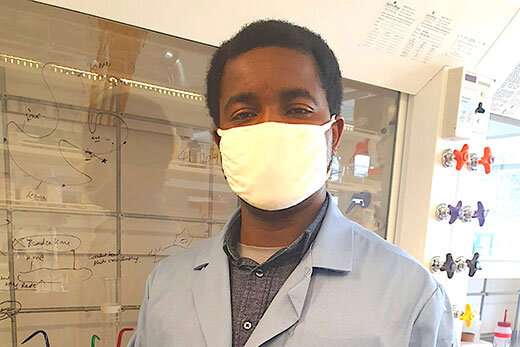Chemists developed a method to detect changes in proteins that may signal the early stages of cancer, Alzheimer’s, diabetes and other major diseases. Angewandte Chemie published the work, led by chemists at Emory University and Auburn University. The results offer a novel strategy for studying links between unique protein modifications and various pathologies.
“The knowledge we gain using our new, chemical method holds the potential to improve the ability to detect diseases such as lung cancer earlier, when treatment may be more effective,” says Monika Raj, senior author of the paper and Emory associate professor of chemistry. “A detailed understanding of protein modifications may also help guide personalized, targeted treatment for patients to improve a drug’s efficacy against cancer.”
The researchers provided a proof of concept for using their method to detect single protein modifications, or monomethylation. Their lab experiments were conducted on the protein lysine expressed from E.coli and other non-human organisms.
Lysine is one of the nine essential amino acids that is critical to life. After lysine is synthesized in the human body, changes to the protein, known as methylation, can occur. Methylation is a biochemical process that transfers one carbon atom and three hydrogen atoms from one substance to another. Such modifications can occur in single (monomethylation), double (dimethylation) or triple (trimethylation) forms. Demethylation reverses these modifications.
The small tweaks of methylation and demethylation regulate biological on-off switches for a host of systems in the body, such as metabolism and DNA production.
“In a normal state, the methylation process creates modifications that are needed to keep your body functioning and healthy,” says Ogonna Nwajiobi, an Emory Ph.D. student in chemistry and first author of the paper. “But the process can get hijacked, creating modifications that may lead to diseases.”
Modifications to lysine, in particular, he adds, have been linked to the development of many cancers and other diseases in humans.
Sriram Mahesh, from Auburn University is co-first author of the paper. Xavier Streety, also from Auburn, is a co-author.
The Raj lab, which specializes in developing organic chemistry tools to understand and solve problems in biology, wanted to devise a method to detect monomethylation marks to lysine that have been expressed by an organism. Monomethylation is especially challenging to detect since it leaves negligible changes in the bulk, charge or other characteristics of a lysine modification.
The researchers devised chemical probes, electron-rich diazonium ions, that couple only with monomethlyation sites at certain biocompatible conditions that they can control, including a particular pH level and electron density. They used mass spectroscopy and nuclear magnetic resonance techniques to show that they had selectively hit the correct targets, and to confirm the coupling of atoms at the sites.
The method is unique because it directly targets the monomethylation sites. Another unique feature of the method is that it is reversible under acidic conditions, allowing the researchers to uncouple the atoms and regenerate the original state of a monomethylation site.
The Raj lab now plans to collaborate with researchers at Emory’s Winship Cancer Institute to test the new method on tissue samples taken from lung cancer patients. The goal is to home in on differences in lysine monomethylation sites of people with and without lung cancer.
“It’s like a fishing expedition,” Nwajiobi explains. “The first step is to use our method to find the lysine monomethylation sites in tissue samples, which is difficult to do because of their low abundance. Once we’ve found the sites, our method then allows us to reverse the coupling with our chemical probe, so the functions of the sites can be studied in their intact, original forms.”
Practical methods for early detection of many diseases, like lung cancer, are needed to help improve patient outcomes. “If we can develop more ways to identify lung cancer earlier, that may open the door for treatments that greatly improve the survival rate,” Raj says.
The researchers hope to study lysine monomethylation differences between samples taken from patients at different stages of lung cancer, between patients with or without a family history of the disease, and between those who have smoked and those who have not. Knowledge gained from such analyses could set the stage for more personalized, targeted treatments, Raj says.
Her lab is also developing chemical tools to selectively detect lysine dimethylation and trimethylation sites, in order to help more fully characterize the role of lysine methylation in disease.
“We hope that other researchers will also apply our methods, and the chemical tools we are developing, to better understand a range of cancers and many other diseases associated with lysine methylation,” Raj says.
Researchers reveal the first cryo-EM structures of NSD2 and NSD3 in complex with nucleosome
More information:
Ogonna Nwajiobi et al. Selective Triazenation Reaction (STaR) of Secondary Amines for Tagging Monomethyl Lysine Post‐Translational Modifications, Angewandte Chemie International Edition (2020). DOI: 10.1002/anie.202013997
Citation:
Chemists develop tools that may help improve cancer diagnostics, therapeutics (2021, April 9)
retrieved 11 April 2021
from https://phys.org/news/2021-04-chemists-tools-cancer-diagnostics-therapeutics.html
This document is subject to copyright. Apart from any fair dealing for the purpose of private study or research, no
part may be reproduced without the written permission. The content is provided for information purposes only.



